
‘Principled action’
A retrospective on the impactful U-M career of departing dean Alec D. Gallimore.

A retrospective on the impactful U-M career of departing dean Alec D. Gallimore.
From his start as a rocket scientist and educator 30 years ago, departing Robert J. Vlasic Dean of Engineering Alec Gallimore has served Michigan Engineering as a connector, a broadener of perspectives, and a champion for the strong engineering fundamentals that made him who he is. The legacy he leaves is a bold vision, not only for the College, but for the future of the field of engineering.
As a leader, Gallimore encouraged collaboration across disciplines and organizations—and made that easier for faculty members, students and staff to accomplish with unconventional programs and facilities. He stood up for diversity in all forms and took the concept of inclusion to heart. Gallimore worked to support and grow the ranks of students, staff, faculty members and leaders from historically underrepresented groups, while at the same time welcoming diversity of perspectives.
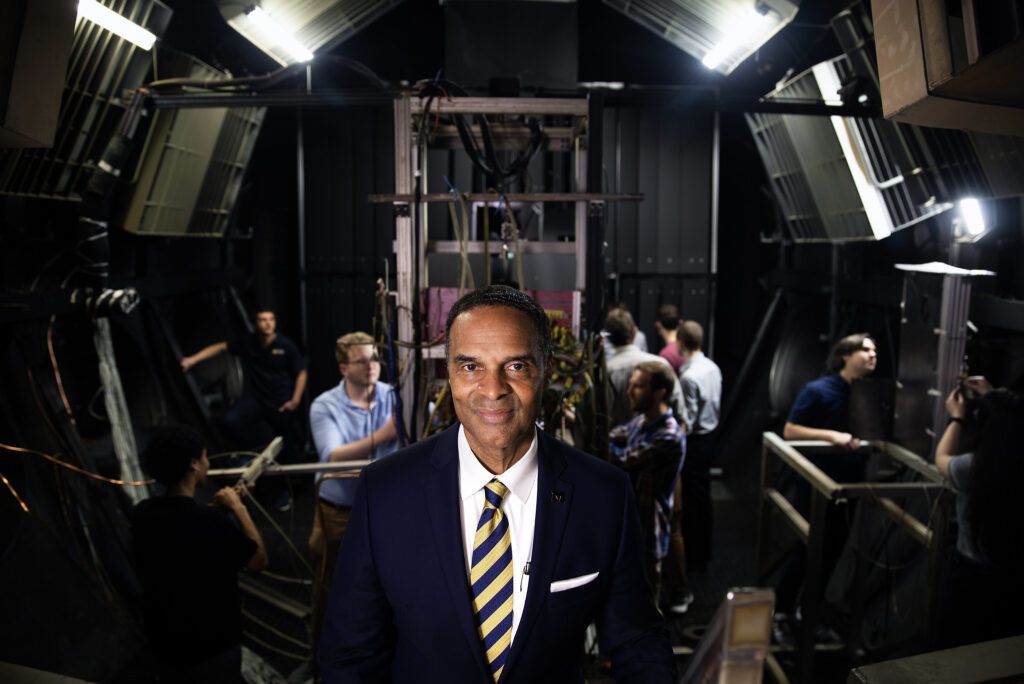
Ultimately, he led the development of a new way to approach the teaching and practice of engineering that promises not only to create a research environment that facilitates solving the problems of the day, but also to equip tomorrow’s engineers with the knowledge and tools to build solutions that don’t exacerbate societal gaps—solutions that serve everyone.
During his decades as a U-M faculty member, Gallimore upcycled an Apollo-era lunar rover testing facility into one of the world’s leading electric propulsion research labs. The abandoned “space simulation chamber” he inherited as an assistant professor became the largest vacuum chamber of its kind at a US university. Today, researchers there are testing thrusters that are among the most promising to carry humans to Mars.
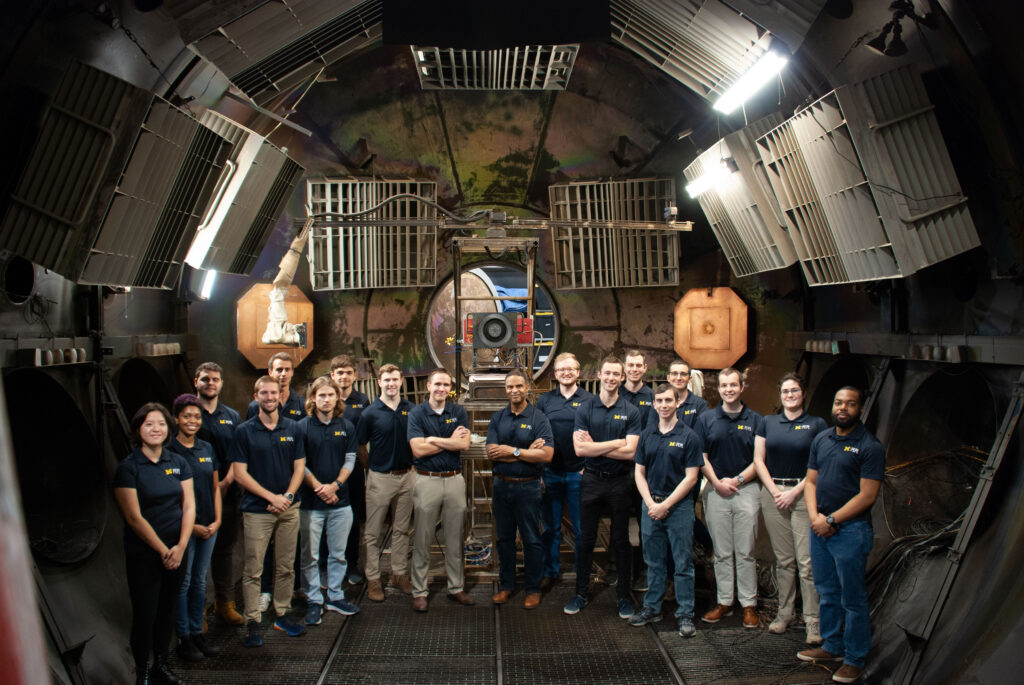
His lab transformation required ingenuity and dedication—qualities he brought to his leadership as well. In the dean’s office, he launched innovative seed funding programs and advanced new ways to connect researchers across fields of study and beyond academia. It has long been known that the most interesting and urgent problems lay at the boundaries of different disciplines. But academia’s conventional structure and the siloed nature of funding bodies mean that it’s hard to build the coalitions needed to approach those problems. In various leadership positions, Gallimore led, co-led and supported efforts to overcome these barriers.
Under Gallimore’s tenure, the College developed the first Robotics Department at a top-10 US engineering school and put researchers from 23 different buildings and ten Top 10 programs together under one roof in the $75 million Ford Motor Company Robotics Building. Through a unique agreement, the fourth floor houses Ford’s first robotics and mobility research lab on a university campus.
These achievements grew out of the first assignment Dave Munson, the previous dean, gave Gallimore back in 2011. The idea of robotics as something like an institute had been explored in the 1980s but hadn’t gone anywhere, he says. His charge as an associate dean gave it new momentum. As sensor technology advanced and brought to light robotics’ true potential, he supported faculty from mechanical engineering, aerospace engineering and electrical engineering and computer science coalescing around the emerging discipline—led by Dawn Tilbury, who is now the Ronald D. and Regina C. McNeil Department Chair of Robotics.
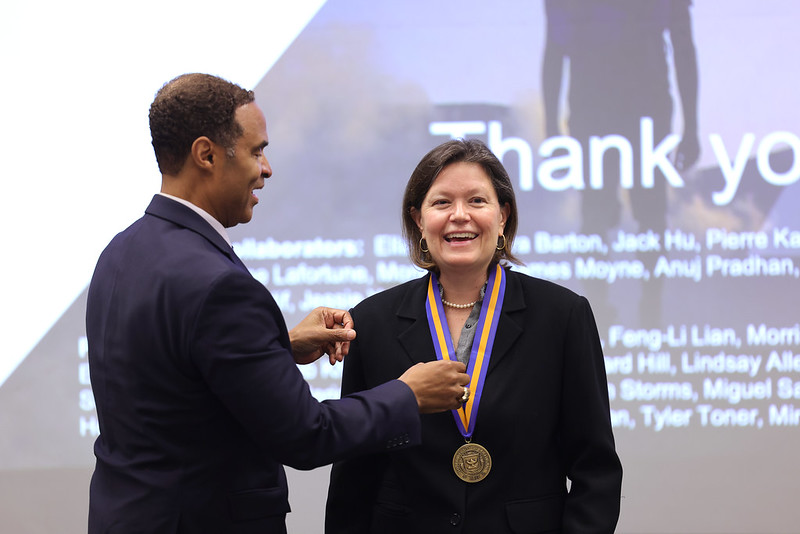
The Robotics Institute launched in 2016, and Gallimore named as its first and only director Jessy Grizzle, the Elmer G. Gilbert Distinguished University Professor. Less than two years later, in 2018, the university broke ground on the building, a 134,000 square foot complex with specialized spaces for robots that walk, roll, swim and fly—covering everything from self-driving cars to prosthetics and exoskeletons to drones. The facility opened in 2021.
Later that year, Robotics became a department. The robotics program has already graduated 234 Master’s students and 27 PhDs, and the department currently enrolls 165 Master’s and 102 PhD students as well as 98 undergraduates who have declared the robotics major since it first became available last fall.
“Alec’s enthusiasm and support for robotics helped us get through the building planning, institute launching, and eventually, the new department,” said Tilbury.
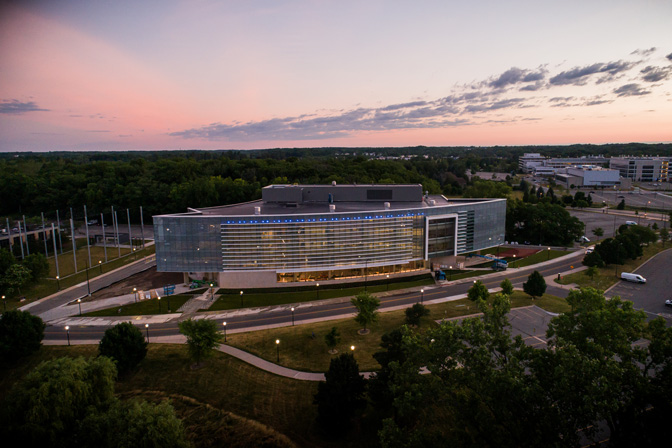
Down the road from Robotics, the Leinweber Computer Science and Information Building is another effort to accelerate interdisciplinary progress through proximity. Funded with a $25 million gift from the Leinweber Foundation, it will enable faculty in the School of Information to work alongside those in computer science and engineering—and closer to their colleagues in Robotics.
In addition to setting up spaces to enable collaboration, funding is a significant roadblock for passionate faculty from different schools and colleges. It’s a chicken and egg problem: the funding agencies want preliminary results, but the prospective teams can’t get funding for those experiments.
By the time he became dean, Gallimore had already been a key player in innovating around this hurdle through the creation of Mcubed. Mark Burns, the T.C. Chang Professor of Engineering and the chair of chemical engineering at the time, and Thomas Zurbuchen, then the associate dean for entrepreneurship, had been developing an idea to enable faculty members to join forces and get those early results.
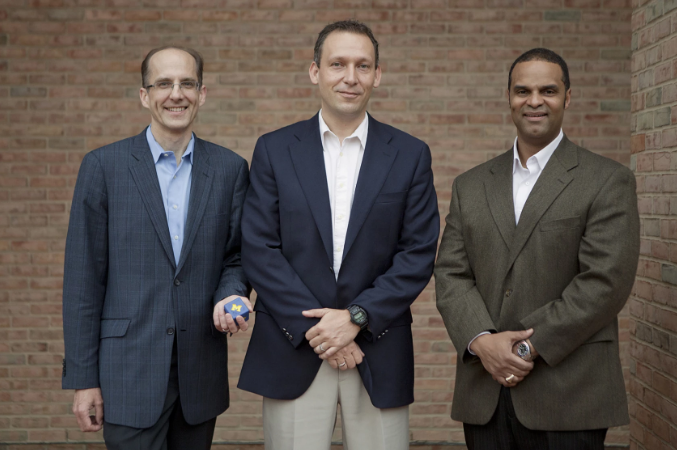
Gallimore, then associate dean for research and graduate education, worked with his colleagues to hammer the idea into a plan: If three faculty members from different departments—at least one of which must hail from a different school or college—came together around an idea, they could get $60,000 in funding.
Mcubed represented a leap of faith that academia hadn’t taken before—unlike ordinary funding mechanisms, there was no review. The choice for very different researchers to buy into the same idea was the review, the founders believed. And it paid off in a big way.
Six years into the program, in 2018, the $27 million investment from U-M and its faculty members yielded more than $120 million in external funding, more than 320 publications, roughly 50 artistic and scholarly products and 20 invention disclosure reports or patents.
The same year, in 2018, the College launched the Blue Sky initiative. Under the leadership of then Associate Dean for Research Steve Ceccio, the seed funding was deployed as mini-centers to support high-risk/high-reward work. Ultimately, each of the four projects received $1.6 million.
The initiative has proven successful in launching big ideas. The Global CO2 Initiative, for example, has brought in an additional $7.35 million in federal and philanthropic funding, and is pursuing an Engineering Research Center that has the potential to bring in more than $60 million. The quantum engineering team, which explored how to produce fuels with solar power and create efficient ultraviolet LEDs, has brought in roughly $20 million, and its members have gone on to spearhead efforts to organize quantum research at the university.
Beyond facilities and funding, numerous institutions and initiatives have sprung up under Gallimore’s watch.
Even as an early-career professor, Gallimore’s leadership style centered around providing support to achieve high expectations, enabling those he taught and advised to bring creativity in problem-solving. When he took the reins of the College, he brought that same philosophy of guidance and autonomy.
This began on day one. Before working with his leadership team to set down a plan, Gallimore met with other college deans as well as Michigan Engineering donors and alums to understand their perspectives and hear their ideas.
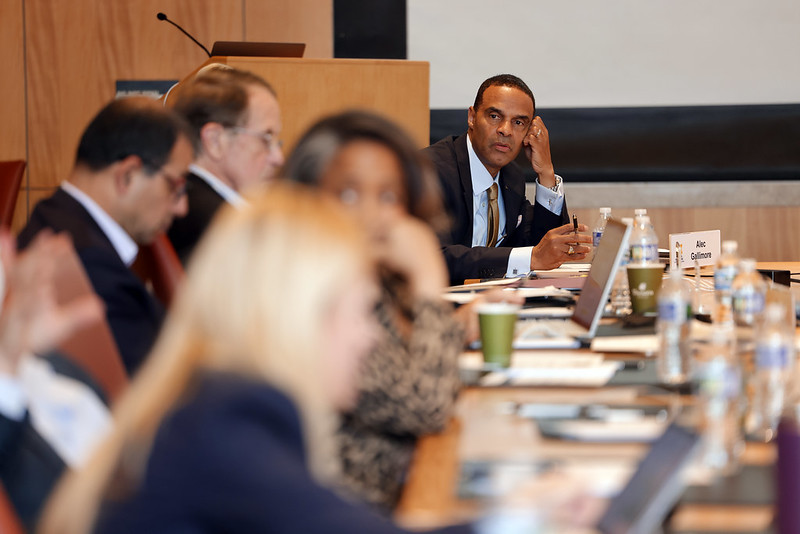
He put together a diverse team that laid out a vision, mission, values and pillars, known as “Michigan Engineering 2020.” Then, throughout his seven years as dean, Gallimore set aside time for faculty, staff and students to meet with him in small groups so he could hear ideas, concerns and feedback. He also assembled a Leadership Advisory Board of top minds from across the industry and higher education to challenge plans and spur new ideas.
“What I’ve often said is that on numerous occasions I witnessed, when CoE leadership had to make a major decision, someone would invoke our values. The values provided a strong framework for principled action,” said Byron Roberts, who was then the College’s deputy chief of staff.
“Opinions might clash over an issue, or even in the interpretation of how the values applied in a given situation. But we were never operating based on the whims of circumstance or personal preference,” said Roberts.
It was through that journey of listening to people inside and outside the College that the concept of “People-first Engineering” emerged as an area in which Michigan Engineering was poised to lead.
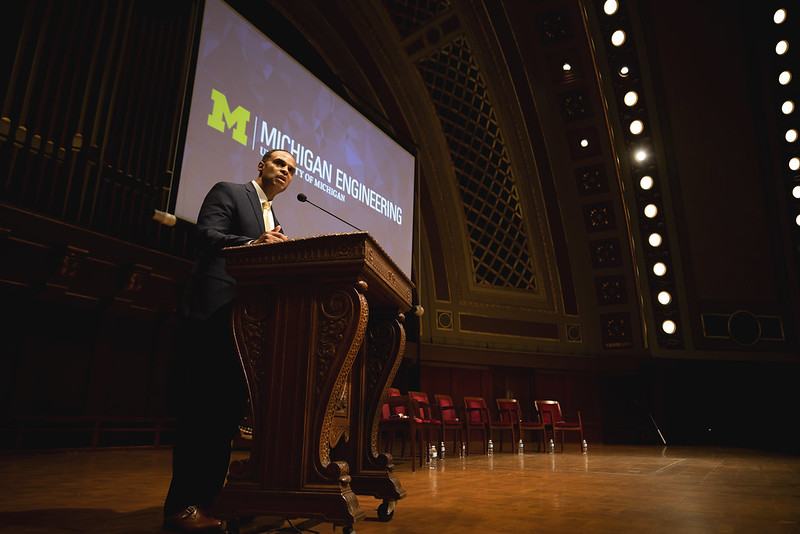
A focus on culture is sometimes criticized in engineering for being “soft” and distracting from technical advances, but Gallimore’s leadership, both as a researcher and administrator, has shown that this is not the case.
While the late 2000s made “interdisciplinary” a buzzword, a growing awareness that homogeneity hurts teams brought the value of identity diversity into the conversation about the quality of engineering solutions. Gallimore’s work as an administrator has pursued both of these challenges.
As a research professor and as an administrator, he has taken care to bring in not only excellent engineers, but engineers who differ from one another. Gallimore’s lab has graduated 47 PhD students, six of whom are Black Americans—on track with the proportion of the population. With universities nationwide awarding less than five percent of engineering PhDs to Black students, Gallimore suggests that what enabled him to more than double that statistic is a supportive lab culture.
“Excellent people of color want to work in excellent environments,” said Mitchell Walker (PhD Aero ’04), now a professor of aerospace engineering and associate dean at Georgia Tech. “He was willing to show others how to be successful in a very diverse environment, in which learning and teaching happens on both sides.”
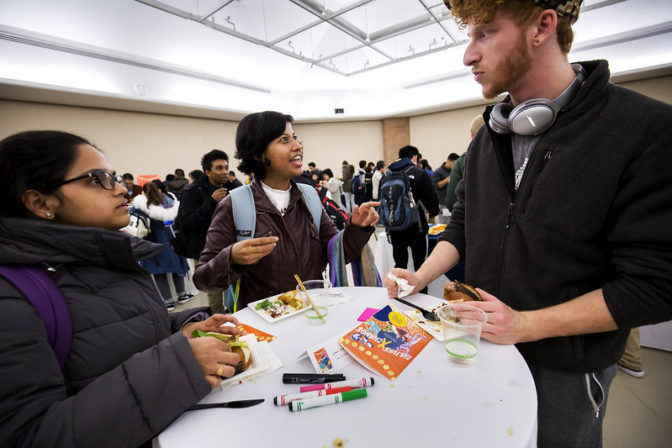
In administration, this philosophy of listening as well as teaching fostered a controversial degree of tolerance for perspectives that some regard as racist or sexist. Gallimore often advises others not to judge individual perspectives as moral failings.
“I remind myself that if I had the same life experiences as they did, I might believe what they believe,” he told gatherings of students and staff.
As a result, he sees educating others about experiences they aren’t aware of, and seeking to understand experiences unfamiliar to him, as key aspects of the work of leadership—and of engineering.
“Inclusion needs to be for everyone,” he said. “You want to make sure when you talk about DEI, you’re not excluding parts of the community.”
As a researcher in electric propulsion, Gallimore has been the only Black engineer in a lot of rooms, but he always made it clear what he had to offer, and he always felt he belonged. As far as he can tell, everyone he worked with believed he did too.
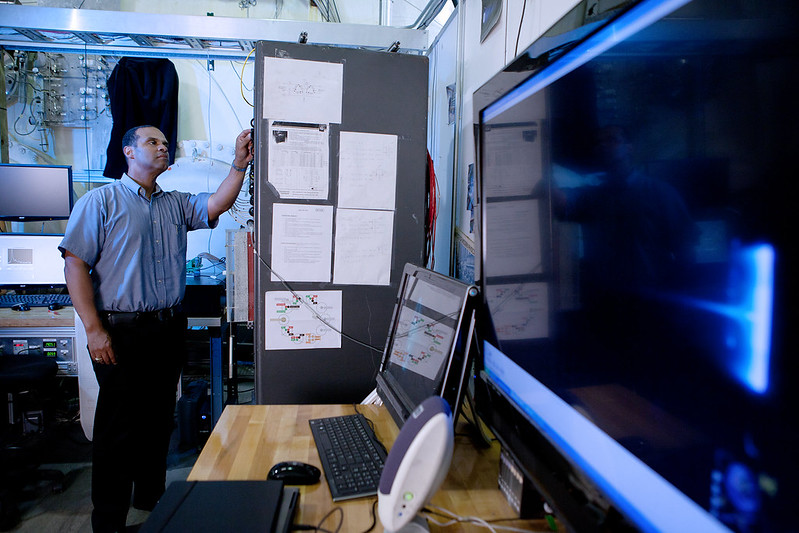
This is the advice he gives to students of color: You do belong, and if you demonstrate what you bring to the table, the people around you will welcome you in.
Still, he recognizes that it’s not always easy or even fair. He’s checked in with many students of color, and they’ve sought him out. Gallimore recounted one conversation with a Black student who had seen his classmates, mainly white and Asian students, turn away from him when they were expected to do group work. He didn’t get the presumption of competence, of camaraderie, that they offered one another.
“I don’t sugarcoat it,” said Gallimore. “I’m basically saying, ‘Yeah, these things happen, and here’s how I try to deal with it.’”
Gallimore didn’t hear more from the student, but in time, he found that the young man had taken his advice.
“I just remember seeing him about two years later, and he’s with a group of white and Asian students, and he was bopping down the hallway like one of them,” said Gallimore. “I mean just bopping—skipping—and talking with them. He looked at me and smiled. I’ll never forget that. He belonged, and he saw that.”
This power-through model for dealing with bias is criticized by many with historically excluded identities because it can be a heavy psychological burden. But for Gallimore, who didn’t feel that weight as much, it helped enable him to achieve in a world where every Michigan Engineering dean before him was a white man. Now, he and the cohort of leaders he has helped to build are smoothing the pathways for those who come next.
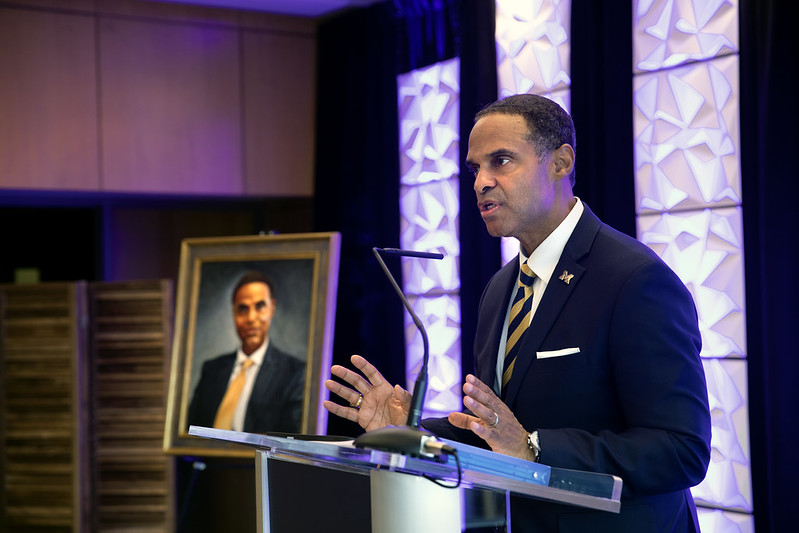
Gathering people from different disciplines is one part of the diversity problem for engineering teams, and another piece is assembling teams with a variety of life experiences and perspectives.
The College has made major leaps in the diversity of its leadership during Gallimore’s tenure. He’ll be the first to tell you that these changes build on the work of people before him—and that they’re only a start.
Notably, when the College’s faculty administrative leadership first exceeded 50% women, he laid out how it had come to pass—highlighting the groundwork underway for more than a decade that brought in female faculty members and provided support to help them thrive. With a cohort of excellent researchers and prepared administrators available to take on these roles, he saw his main purpose as creating a process that would encourage them to come forward—and that would showcase their additional strengths.
Even so, female faculty members have hovered around 20% of the tenure and tenure-track population. Likewise, historically excluded minorities make up just 8% of the faculty. To encourage more graduate students to consider faculty life—and to prepare them for the interview process—Gallimore founded the NextProf Future Faculty program.
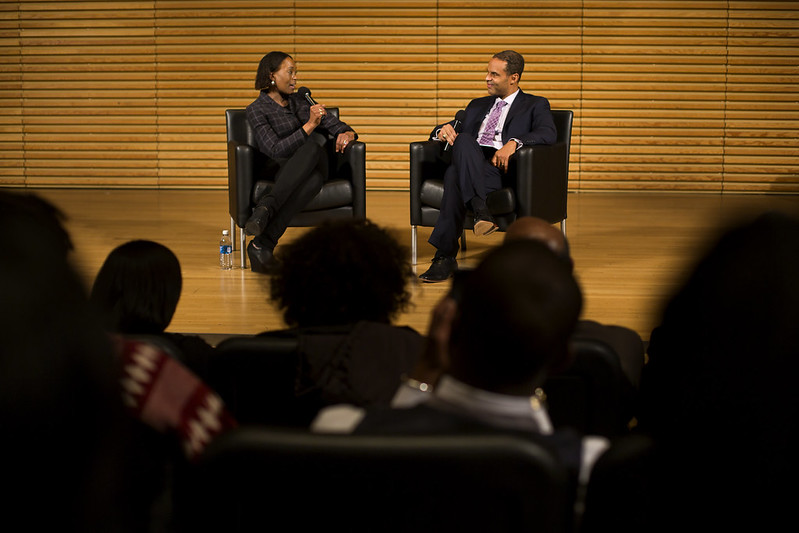
“We designed the program to be intense, preparing students for faculty visits. It was like speed dating, where they would meet many faculty members one after the other,” said Gallimore. “The other side of that is ensuring the participating faculty could no longer believe that these quality candidates from underrepresented backgrounds weren’t out there.”
NextProf thrived, traveling to other campuses such as the University of California, Berkeley and Georgia Tech. In addition, the program expanded to include not just PhD students within striking distance of graduation, but also earlier PhD students who had more time to develop a portfolio for faculty applications and Master’s students considering a PhD as a pathway to a professorship.
“The NextProf program has had a massive impact on the diversity of engineering faculty nationally, with close to 600 participants over the last ten years and close to 200 in tenure track faculty positions nationwide—a testament to Alec’s extraordinary vision for academic leadership,” said Lola Eniola-Adefeso, the associate dean for graduate and professional education and the University Diversity and Social Transformation Professor of Chemical Engineering, who has helped develop the NextProf programs from the beginning.
Like faculty numbers, student enrollment percentages for underrepresented minorities and women have flatlined for the last 15 or 20 years with the exception of female PhD students, which are up by roughly 70% over the last two decades to make up 27% of the enrollment for 2022.
Part of the problem is that the engineering community is largely unaware of how the culture excludes some groups—and how that exclusion affects the solutions that engineers produce. In the fall of 2020, the Michigan Engineering leadership set out a plan to educate all students, faculty and staff on how historical inequalities played out in engineering and continue to affect the field today. This plan is coming to fruition in part through the Teaching Engineering Equity (TEE) Center, which is preparing case studies to be used in courses and teaching educators how to lead these discussions, threaded through technical coursework.
The TEE center was just one piece of a vision to help correct the role engineering can play in exacerbating societal disparities—a vision that began to take shape after the murder of George Floyd in the spring of 2020. Another piece of this effort was to broaden the support offered by the College’s diversity arm. The Center for Engineering Diversity and Outreach (CEDO), which focused on recruiting and retaining students from historically excluded backgrounds, became a part of the new Office of Culture, Community and Equity (OCCE).
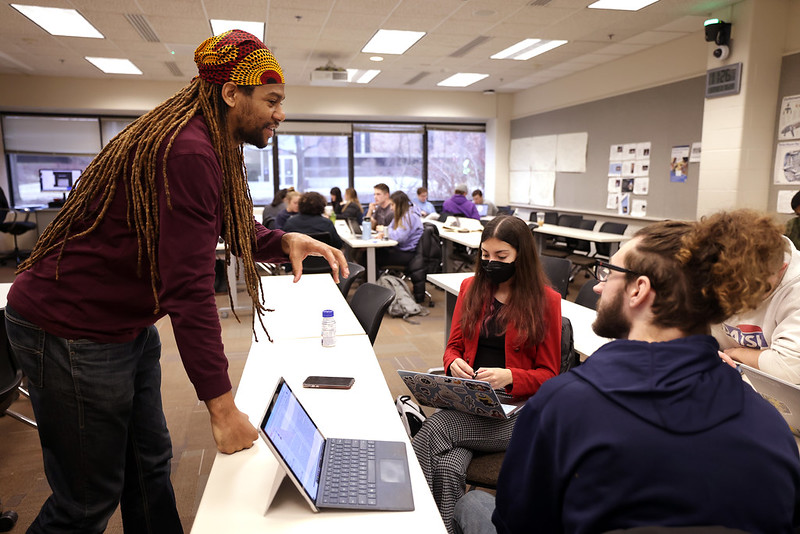
“There’s a ton of work going on, some from the College, some from academic units, and we needed to create a way for people to share what they were doing, learn from one another, and then also a place that would be our link to the Office of Diversity, Equity and Inclusion on central campus,” said Lyonel Milton, formerly the director of CEDO and now the managing director of OCCE. “The new structure enables us to harness the power of all this activity.”
Beyond the College, the concept of equity-centered engineering, now central to Michigan Engineering’s identity, seeks to affect the field at large. Gallimore laid out that vision in an opinion article for Inside Higher Ed. In addition to being the right thing to do, this ambition sets Michigan Engineering apart from other great engineering schools as a leader offering a pathway to meaningful change that the rising generation is ready to drive.
These threads come together in the “People-first Engineering” framework established over the last several years of Gallimore’s leadership. The framework also addresses gaps that were identified in a 2021 Michigan Engineering survey of engineers, recruiters, deans and department chairs to assess where the field of engineering education is, and should be, headed.
A primary finding was the belief that engineering education needs to evolve to serve humanity not only technologically, but also societally. Roughly 80% of respondents believe schools must teach both excellent engineering fundamentals and the social impacts of engineering. But only 45% believe institutions are currently prepared to teach both.
“We were in the second category already,” Gallimore said. “But we felt more needed to be done. The people-first approach we developed is built on a foundation of excellent technical skills. On top of that, it requires looking to other disciplines to understand the impacts of our work, as well as operating from an equity-centered, global mindset. It’s truly a reimagining of what engineering can be.”
The people-first framework is less a revolution than it is an evolution of how Gallimore has led his teams along the way—fostering excellent engineering, spurring collaborative innovations and instilling equitable values.
“I’m proud of all we’ve been able to accomplish together,” Gallimore said, “and have complete faith that the excellent leadership team and community here at Michigan Engineering will continue that progress long into the future.”
Gallimore is also the Richard F. and Eleanor A. Towner Professor of Engineering, an Arthur Thurnau Professor and a professor of aerospace engineering. Tilbury is also the Herrick Professor of Engineering and a professor of mechanical engineering and electrical engineering and computer science. Grizzle is also the Jerry W. and Carol L. Levin Professor of Engineering. Burns is also a professor of chemical engineering. Eniola-Adefeso is also a professor of chemical engineering and macromolecular science and engineering.